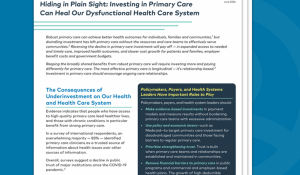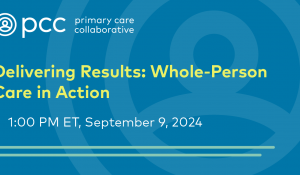You are looking at an archived version of our site. Please visit thepcc.org for a fresh, new experience!
You are here: Array » Primary Care Remains W ...
Primary Care Remains Weakened in Fight Against COVID-19
WASHINGTON, July 24, 2020 – The Larry A. Green Center, in collaboration with the Primary Care Collaborative (PCC), today released new data showing nearly 9 in 10 primary care practices continue to face significant difficulties with COVID-19, including obtaining medical supplies, meeting the increasing health needs of their patients, and finding sufficient resources to remain operational. Only 13% of responding primary care clinicians say they are adapting to a “new normal” in the protracted pandemic.
This data comes more than four months into the pandemic and at a time when 39 states are experiencing an increase of COVID-19 cases, straining the nation’s healthcare system again.
The data also reveals that fewer than 4 in 10 clinicians feel confident and safe with their access to personal protective equipment; 11% report that staff in their practice have quit in the last four weeks over safety concerns.
“In the first few months of the pandemic, the country pulled together to stop the spread of the virus, and it seemed like we were making progress. Primary care clinicians and practices were working hard, against tremendous challenges,” said Rebecca Etz, PhD, co-director of The Larry A. Green Center. “But now the country is backsliding, and it’s clear that primary care doesn’t have enough strength to deal with the rising number of cases. If primary care were a COVID-19 patient, it would be flat on its back.”
The survey conducted by the Larry A. Green Center is part of an ongoing series looking at the attitudes of primary care clinicians and patients during the COVID-19 pandemic and the abilities of practices to meet patients’ needs. This week’s data also showed that in addition to feeling stressed, clinicians and their practices are also experiencing upheaval. 22% of clinicians report skipped or deferred salaries, and 78% report preventive and chronic care is being deferred or delayed by patients.
“Given the rapidly rising infection rates and persistent lack of PPE, more than a third of primary care clinicians are reporting feeling unsafe at the office, and 20% are cutting back on face-to-face visits while doing more remote outreach,” said Ann Greiner, president and CEO of the Primary Care Collaborative. “This is a clear signal that all payers must advance or retain parity for telehealth and telephonic calls. But it also is a clarion call to move to a new payment system that doesn’t rely on face-to-face visits and that is prospective so practices can better manage patient care.”
The survey of clinicians was fielded July 10-13, 2020, and received 594 responses from 46 states and Puerto Rico. 71% of respondents identify their practice as family medicine, 12% as internal medicine, 8% as pediatrics, 4% as geriatrics, and 5% as other. Settings include 21% rural, 14% community health centers, 11% in schools/offices, and 29% in designated patient-centered primary care homes. 33% have 1-3 clinicians in the practice, 27% have 4-9 clinicians, 39% have more than 10 clinicians. 39% are owned by a health system, 33% are self-owned, 12% are independent and large-group, and 4% are government-owned. 6% are convenience settings, and 5% are membership-based.
###
Visit PCC’s website for:
- more details on the survey findings
- executive summary of the survey
- infographic
Experts are available to provide insight and comment on the survey:
- Ann Greiner, president and CEO of the Primary Care Collaborative
- Rebecca Etz, PhD, co-director of The Larry A. Green Center
If you would like to speak with them, please contact Stephen Padre (Primary Care Collaborative's communications manager), spadre@pcpcc.org, 202-417-3911

Are you a physician, nurse practitioner, or PA working in primary care?
Help PCC and the Larry A. Green Center track how your practice is responding to the COVID-19 outbreak by completing the Green Center's occasional survey.
The regular surveys are no longer being conducted.
COVID-19 Updates
May 9, 2022 | Primary Care Collaborative
April 19, 2022 | Primary Care Collaborative
April 19, 2022 | Primary Care Collaborative
March 7, 2022 | STAT
February 27, 2022
- 1 of 39
- next ›
Recent News
August 16, 2024
August 12, 2024
July 16, 2024
May webinar highlights: “The Commercial Market: Alternative Payment Models for Primary Care” Nate Murray explains w… https://t.co/KX9Wi2w6oY —
2 years 5 months ago
@CMSinnovates’ primary care strategy is rooted in a 2021 @theNASEM’s report which called #primarycare “foundational… https://t.co/glbPxvCysg —
2 years 5 months ago
@CMSinnovates has a new #primarycare strategy, envisioning “ACO-based primary care model tests that may focus on pr… https://t.co/aJGF1z411l —
2 years 5 months ago
- Page 1
- ››
Secondary menu
Copyright © 2024 Primary Care Collaborative



